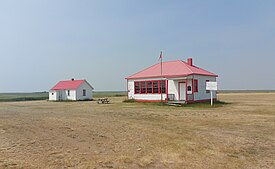The Rural Municipality of Happyland No. 231 (2021 population: 285) is a rural municipality (RM) in the Canadian province of Saskatchewan within Census Division No. 8 and SARM Division No. 3. Located in the southwest portion of the province, it is adjacent to the Alberta boundary and south of the South Saskatchewan River.
Happyland No. 231
Prussia No. 231 (1913 – 1917) | |
|---|---|
| Rural Municipality of Happyland No. 231 | |
 St. John's School | |
 Location of the RM of Happyland No. 231 in Saskatchewan | |
| Coordinates: 50°53′56″N 109°34′41″W / 50.899°N 109.578°W[1] | |
| Country | Canada |
| Province | Saskatchewan |
| Census division | 8 |
| SARM division | 3 |
| Federal riding | Cypress Hills—Grasslands |
| Provincial riding | Cypress Hills |
| Formed[2] | January 1, 1913 |
| Name change[3] | 1917 (from RM of Prussia No. 231) |
| Government | |
| • Reeve | Timothy Geiger |
| • Governing body | RM of Happyland No. 231 Council |
| • Administrator | Kim Lacelle |
| • Office location | Leader |
| Area (2021)[5] | |
| • Land | 1,269.18 km2 (490.03 sq mi) |
| Population (2021)[5] | |
| • Total | 285 |
| • Density | 0.2/km2 (0.5/sq mi) |
| Time zone | CST |
| • Summer (DST) | CST |
| Area code(s) | 306 and 639 |
| Highway(s) | |
| Railway(s) | Great Sandhills Railway |
History edit
On January 1, 1913, the RM of Happyland No. 231 became a rural municipality.[2] It was originally named the RM of Prussia No. 231 but its name was changed sometime during 1917, at the height of the First World War and anti-German sentiment in Saskatchewan.[3]
Geography edit
Communities and localities edit
The following urban municipalities are surrounded by the RM.
The following unincorporated communities are within the RM.
- Localities
Demographics edit
In the 2021 Census of Population conducted by Statistics Canada, the RM of Happyland No. 231 had a population of 285 living in 110 of its 140 total private dwellings, a change of 14.5% from its 2016 population of 249. With a land area of 1,269.18 km2 (490.03 sq mi), it had a population density of 0.2/km2 (0.6/sq mi) in 2021.[5]
In the 2016 Census of Population, the RM of Happyland No. 231 recorded a population of 249 living in 101 of its 113 total private dwellings, a -12.3% change from its 2011 population of 284. With a land area of 1,259 km2 (486 sq mi), it had a population density of 0.2/km2 (0.5/sq mi) in 2016.[8]
Government edit
The RM of Happyland No. 231 is governed by an elected municipal council and an appointed administrator that meets on the second Tuesday of every month.[4] The reeve of the RM is Timothy Geiger while its administrator is Kim Lacelle.[4] The RM's office is located in Leader.[4]
Transportation edit
- Rail
- Roads
- Highway 21—serves Leader, Liebenthal
- Highway 32—serves Leader, Prelate
- Highway 321—serves Liebenthal
References edit
- ^ "Pre-packaged CSV files - CGN, Canada/Province/Territory (cgn_sk_csv_eng.zip)". Government of Canada. July 24, 2019. Retrieved May 23, 2020.
- ^ a b "Rural Municipality Incorporations (Alphabetical)". Saskatchewan Ministry of Municipal Affairs. Archived from the original on April 21, 2011. Retrieved May 9, 2020.
- ^ a b Barry, Bill (1998). People Places : The Dictionary of Saskatchewan Place Names. Regina, Saskatchewan: People Places Publishing Ltd. ISBN 1-894022-19-X.
- ^ a b c d "Municipality Details: RM of Happyland No. 231". Government of Saskatchewan. Retrieved May 21, 2020.
- ^ a b c "Population and dwelling counts: Canada, provinces and territories, census divisions and census subdivisions (municipalities), Saskatchewan". Statistics Canada. February 9, 2022. Retrieved April 13, 2022.
- ^ "Saskatchewan Census Population" (PDF). Saskatchewan Bureau of Statistics. Archived from the original (PDF) on September 24, 2015. Retrieved May 9, 2020.
- ^ "Saskatchewan Census Population". Saskatchewan Bureau of Statistics. Retrieved May 9, 2020.
- ^ "Population and dwelling counts, for Canada, provinces and territories, and census subdivisions (municipalities), 2016 and 2011 censuses – 100% data (Saskatchewan)". Statistics Canada. February 8, 2017. Retrieved May 1, 2020.
